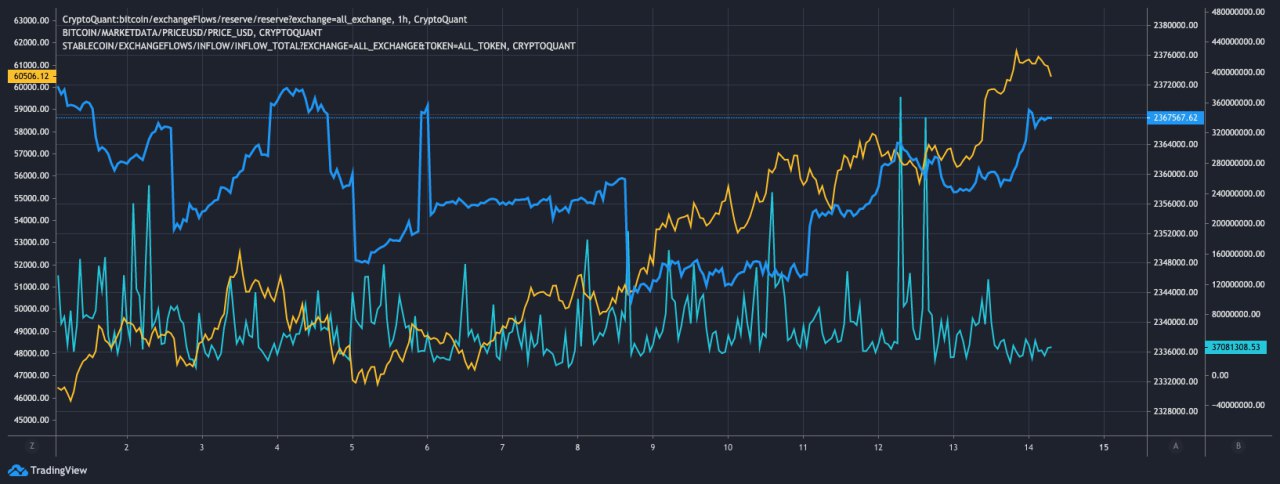Bitcoin (BTC) pared some gains, dipping below $60,000 on March 14, a day after setting a new all-time high of $61,950 on Binance. However, on-chain data indicates that the uptrend is likely to continue in the near term.
One key metric that is signaling an optimistic short-term trend for Bitcoin is the rise in stablecoin deposits into exchanges.
Although high funding rates and an overcrowded market are causing the price to pull back, the entrance of sidelined capital into the crypto market may further boost Bitcoin’s momentum.
Why Bitcoin dropped after $60K breach
When Bitcoin enters price discovery and hits a new record-high, the interest in the market naturally spikes.
There is a lot of liquidity in the current red-hot market, making it an ideal period for whales and high-net-worth investors to take profit on their positions.
 Bitcoin funding rates. Source: Bybt.com
Bitcoin funding rates. Source: Bybt.com
Filbfilb, a pseudonymous trader and technical analyst, noted that high futures market funding rates and Bitcoin deposits into exchanges were spotted before the drop.
The Bitcoin futures market uses a mechanism called “funding” to incentivize traders based on the balance of the market.
For example, if there are more buyers or long contract holders in the Bitcoin futures market, short-sellers are incentivized to sell or short. When this happens, the funding rate increases, making it expensive for traders to long Bitcoin.
Before the drop, the futures funding rate of BTC was hovering in the 0.05% to 0.1% range, which is five to ten times higher than the default 0.01% funding rate. Filbfilb explained:
“Bitcoin temporary selloff after high funding, big net BTC inflows and weekend pump. Guess people thought it was different this time.”
High Bitcoin inflows into exchanges likely fueled the drop because whales often deposit BTC into exchanges when they intend to sell.
Therefore, the combination of the selling pressure coming from whales and the high futures funding rate was the likely reason behind today’s pullback.
How stablecoin inflows can further fuel the BTC rally
But despite, the halt in the rally, stablecoin inflows into exchanges are rising once again, according to the latest data from CryptoQuant.
In the crypto market, traders often hedge their holdings against stablecoins like Tether (USDT) and USDC, rather than cashing out via withdrawals to bank accounts.
Typically, exchanges have a three to seven-day processing period for cash deposits, and when traders want to re-enter the cryptocurrency market, moving cash from their bank accounts back to exchanges becomes cumbersome.
 BiTC exchange reserve (blue), stablecoin inflows (green) vs. BTC price (yellow). Source: CryptoQuant
BiTC exchange reserve (blue), stablecoin inflows (green) vs. BTC price (yellow). Source: CryptoQuant
Hence, when stablecoins begin to flow into exchanges again — as seen by the green spikes in the chart above — it suggests that sidelined capital may be looking to get back into Bitcoin.
Ki Young Ju, the CEO of CryptoQuant, wrote:
“There were many stablecoins inflow transactions to exchanges very frequently. 100-287 stablecoins deposits in each ETH block(15 seconds). I think we’ll see more pumps on $BTC or $ETH in the short-term.”
Throughout the past week, the one missing component during the Bitcoin rally was stablecoin inflows.
When Bitcoin rallies without a noticeable rise in stablecoin inflows, it increases the probability of an unsustainable uptrend and a short-term correction.
If the trend of sidelined capital moving back into the crypto market continues, there is a high probability that this will further fuel Bitcoin’s momentum resulting in a broader rally.






